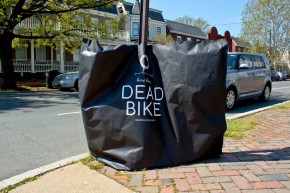Ride, walk, bike, run, or Segway down Broad Street, in Carytown, through Oregon Hill, and around Byrd Park and you will see the Dead Bikes—missing saddles, rusted poles, bent wheels that can no longer be used, rubber sheared off by the pounding sun, rain, and time. Dead Bikes are not to be mistaken for “Ghost Bikes.”

“[Ghost bikes] have become powerful statements in the movement for safer streets,” says National Bike Advocate Noah Budnick. “They send a powerful message. They also mean a lot to people whose loved ones were killed in traffic.”
Dead Bikes, in contrast, are abandoned bikes: an annoying problem that prompted designer James Walker to create a unique public art project where he tagged each bike with a QR code and a shroud that read “here lies a dead bike.” Perhaps you have seen them around town. Scanning the QR code allows you to see the abandoned bike in context with the scores of other dead bikes in the city. In recent months, Walker has moved from QR codes to simply providing a web address (www.deadbicycles.com) that provides further information.
Walker set out to bring renewed appreciation for bicycle culture in RVA. By shrouding these bikes, he feels Richmonders can show their love for bicycles and hope that they’ll get a second chance.
Far from just an interesting public art project, the reality of dead bikes has caused Richmonders to take note and even stirred public policy. Parker Agelasto, of the 5th district, for example, has made it his cause célèbre to get these abandoned and inoperable bikes off the streets. “The more you learn about the bike, the more elbow grease you put into it, the more you will value it,” says Brantley Tyndall, a tireless advocate for biking and the acting executive director of RideRichmond.
Agelasto and Brantley both agree that a system of tagging and eventual removal of abandoned bikes would be a simple solution, especially if carried out consistently and reliably. VCU’s 10-day policy is a good example: A notice is placed on the bike 10 days before it’s to be removed. Still, an existential crisis remains. Urban decay is the underlying tone and the abandoned bikes recall the “broken windows theory” that argues that urban disorder and vandalism, when not properly responded to, can lead to larger acts of violence and crime. Proactive projects by bicycle fans like Walker, however, give Richmonders a reason to go out and explore while helping bring awareness to an important issue in the region. By creating a digital link to abandoned bikes, Richmonders can follow a route (which includes historical information along the way) formed by finding dead bicycles. As a result, Walker has provided cyclists a path to follow to become more involved and another reason to ride their bikes. We have
As RVA prepares itself for the hundreds of thousands projected to attend the 2015 UCI Road Cycling Championships, these are the types of solution-oriented projects we need to create more of in the region. Dead Bikes force the question: What are we willing to do to make sure that the stories bikes tell in Greater Richmond are not one of urban decay but rather one of urban renewal?

